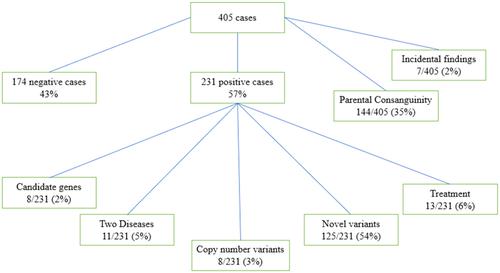当前位置:
X-MOL 学术
›
Clin. Genet.
›
论文详情
Our official English website, www.x-mol.net, welcomes your feedback! (Note: you will need to create a separate account there.)
The utility of exome sequencing in diagnosing pediatric neurodevelopmental disorders in a highly consanguineous population
Clinical Genetics ( IF 3.5 ) Pub Date : 2024-03-04 , DOI: 10.1111/cge.14508 Tamam Khalaf, Mode Al Ojaimi, Dina Amin Saleh, Alena Sulaiman, Aman P. Sohal, Arif Khan, Ayman W. El-Hattab
Clinical Genetics ( IF 3.5 ) Pub Date : 2024-03-04 , DOI: 10.1111/cge.14508 Tamam Khalaf, Mode Al Ojaimi, Dina Amin Saleh, Alena Sulaiman, Aman P. Sohal, Arif Khan, Ayman W. El-Hattab

|
Exome sequencing (ES) has been utilized in diagnosing children with neurodevelopmental manifestations, this study aimed to investigate the utility of ES in children within a highly consanguineous population that presented with neurodevelopmental complaints. A retrospective chart review was performed for 405 children with neurodevelopmental complaints who have had ES and were evaluated in multiple centers in the United Arab Emirates over a four-year period. Within the cohort of 405 children, consanguinity was reported in 35% (144/405). The primary clinical presentations were developmental delay/cognitive impairment, distinctive facial features, hypotonia, seizures, and weakness. The diagnostic yield was 57% (231/405). Novel variants were identified in 54% (125/231) of positive cases. Within the positive cases, specific treatment was available in 6% (13/231) and copy number variants (CNV) were reported in 3% (8/231) of cases. In eight children, variants in genes that have not yet been linked to human disease that could potentially be the cause of the observed phenotype “candidate genes” were identified. ES was utilized effectively within this cohort with a high diagnostic yield and through the identification of novel gene variants, CNVs, candidate genes and secondary findings as well as the alteration of the treatment plan in cases where treatment was available.
中文翻译:

外显子组测序在诊断高度近亲人群的儿童神经发育障碍中的应用
外显子组测序 (ES) 已被用于诊断患有神经发育表现的儿童,本研究旨在调查 ES 在出现神经发育疾病的高度近亲人群中的儿童中的效用。对 405 名患有 ES 的神经发育疾病儿童进行了回顾性图表审查,并在四年内在阿拉伯联合酋长国的多个中心进行了评估。在 405 名儿童中,有 35% (144/405) 有近亲血缘关系。主要临床表现是发育迟缓/认知障碍、独特的面部特征、肌张力低下、癫痫发作和虚弱。诊断率为 57% (231/405)。54% (125/231) 的阳性病例中发现了新的变异。在阳性病例中,6% (13/231) 可以进行特异性治疗,3% (8/231) 的病例报告有拷贝数变异 (CNV)。在八名儿童中,鉴定出尚未与人类疾病相关的基因变异,这些变异可能是观察到的表型“候选基因”的原因。ES 在该队列中得到了有效利用,诊断率很高,并通过识别新的基因变异、CNV、候选基因和次要发现以及在可以治疗的情况下改变治疗计划来实现。
更新日期:2024-03-05
中文翻译:

外显子组测序在诊断高度近亲人群的儿童神经发育障碍中的应用
外显子组测序 (ES) 已被用于诊断患有神经发育表现的儿童,本研究旨在调查 ES 在出现神经发育疾病的高度近亲人群中的儿童中的效用。对 405 名患有 ES 的神经发育疾病儿童进行了回顾性图表审查,并在四年内在阿拉伯联合酋长国的多个中心进行了评估。在 405 名儿童中,有 35% (144/405) 有近亲血缘关系。主要临床表现是发育迟缓/认知障碍、独特的面部特征、肌张力低下、癫痫发作和虚弱。诊断率为 57% (231/405)。54% (125/231) 的阳性病例中发现了新的变异。在阳性病例中,6% (13/231) 可以进行特异性治疗,3% (8/231) 的病例报告有拷贝数变异 (CNV)。在八名儿童中,鉴定出尚未与人类疾病相关的基因变异,这些变异可能是观察到的表型“候选基因”的原因。ES 在该队列中得到了有效利用,诊断率很高,并通过识别新的基因变异、CNV、候选基因和次要发现以及在可以治疗的情况下改变治疗计划来实现。



























 京公网安备 11010802027423号
京公网安备 11010802027423号